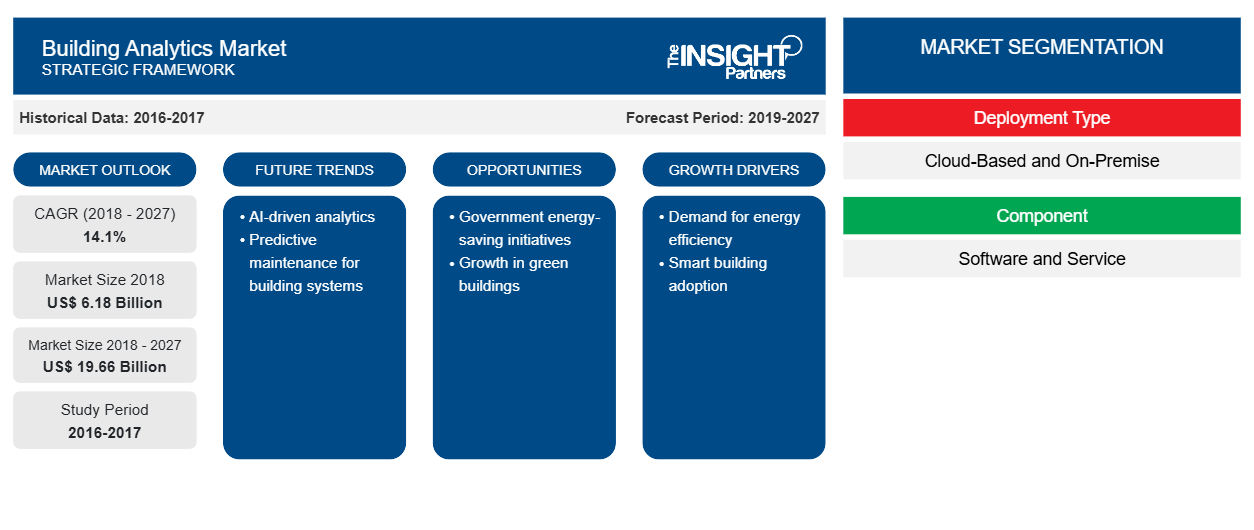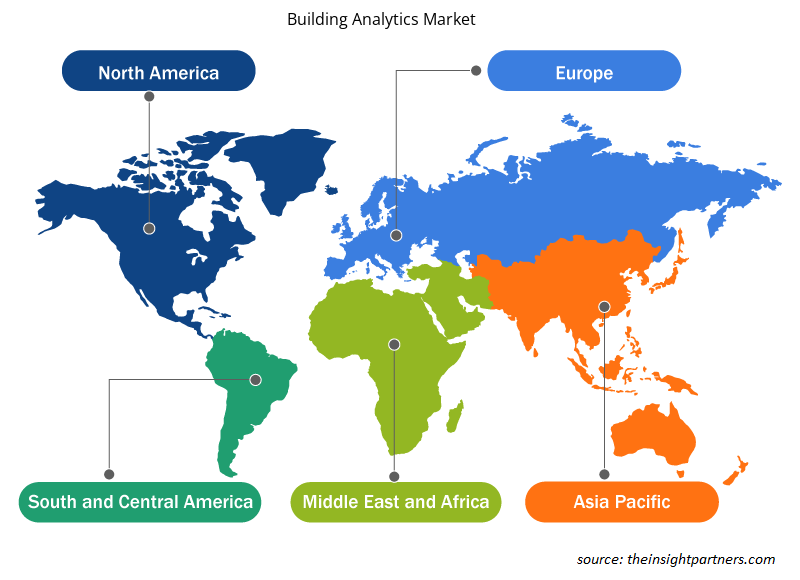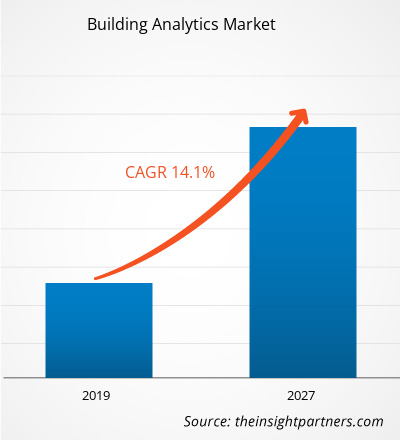The global building analytics market was valued at US$ 6,181.4 million in 2018 and it is expected to grow at a CAGR of 14.1% between 2019 and 2027.
Building analytics market is experiencing growth all across the globe, growing energy prices, increasingly stringent building energy guidelines, and achieving maximum operational efficiency for building and facility management is expected to be the major market driving forces in the coming years.
The report focuses on an in-depth segmentation of building analytics market based on deployment type, component, building type, and application. The geographic segmentation of the report covers five major regions including; North Americas, Europe, Asia-Pacific (APAC), Middle East and Africa (MEA) and South America (SA). The regional market has been further segmented by respective countries. By application, energy management accounted for the largest share in the building analytics market in 2018.
Customize This Report To Suit Your Requirement
You will get customization on any report - free of charge - including parts of this report, or country-level analysis, Excel Data pack, as well as avail great offers and discounts for start-ups & universities
Building Analytics Market: Strategic Insights

- Get Top Key Market Trends of this report.This FREE sample will include data analysis, ranging from market trends to estimates and forecasts.
You will get customization on any report - free of charge - including parts of this report, or country-level analysis, Excel Data pack, as well as avail great offers and discounts for start-ups & universities
Building Analytics Market: Strategic Insights

- Get Top Key Market Trends of this report.This FREE sample will include data analysis, ranging from market trends to estimates and forecasts.
The report aims to provide an overview of the global building analytics market with detailed market segmentation. Also, it analyzes the current building analytics market scenario and forecasts the market till 2027. The report covers market dynamics affecting the building analytics market during the forecast period. Furthermore, the report analyzes the competitive scenario, geographic trends, and opportunities in the building analytics market with respect to all geographic regions. The report also includes the detailed company profiles of the key players in the building analytics market along with their market strategies. The report also provides PEST along with the SWOT analysis for all company profiled in the report.
Currently, the building analytics market penetration rates in Europe region is higher than any other markets across the globe. The European Union's Energy Efficiency Directive, launched in 2012 established a set of obligatory measures to aid the EU achieve its 20% energy efficiency target by 2020. The Directive requires all EU countries to use energy more efficiently throughout the energy chain i.e. from production to final consumption. Also, in 2016, an update to Energy Efficiency Directive was proposed, which included a new 30% energy efficiency target for 2030, as well as measures to meet the new target. In the EU, buildings accounts for around 40% of the total energy consumption and 36% of total CO2 emissions. Also, around 35% of the buildings in the EU are more than 50 years old and nearly 75% of the building stock is energy inefficient, although only 0.4-1.2% of the building stock is restored every year. Thus, more restoration of existing buildings has the prospective to lead to substantial energy savings. Such facts provides a prosperous opportunity to the building analytics market growth.
Building Analytics Market Regional Insights
The regional trends and factors influencing the Building Analytics Market throughout the forecast period have been thoroughly explained by the analysts at The Insight Partners. This section also discusses Building Analytics Market segments and geography across North America, Europe, Asia Pacific, Middle East and Africa, and South and Central America.

- Get the Regional Specific Data for Building Analytics Market
Building Analytics Market Report Scope
| Report Attribute | Details |
|---|---|
| Market size in 2018 | US$ 6.18 Billion |
| Market Size by 2027 | US$ 19.66 Billion |
| Global CAGR (2018 - 2027) | 14.1% |
| Historical Data | 2016-2017 |
| Forecast period | 2019-2027 |
| Segments Covered |
By Deployment Type
|
| Regions and Countries Covered | North America
|
| Market leaders and key company profiles |
Building Analytics Market Players Density: Understanding Its Impact on Business Dynamics
The Building Analytics Market is growing rapidly, driven by increasing end-user demand due to factors such as evolving consumer preferences, technological advancements, and greater awareness of the product's benefits. As demand rises, businesses are expanding their offerings, innovating to meet consumer needs, and capitalizing on emerging trends, which further fuels market growth.
Market players density refers to the distribution of firms or companies operating within a particular market or industry. It indicates how many competitors (market players) are present in a given market space relative to its size or total market value.
Major Companies operating in the Building Analytics Market are:
- Schneider Electric
- International Business Machines (IBM) Corporation
- SkyFoundry
- Environmental Systems, Inc.
- ENGIE Insight Services Inc
Disclaimer: The companies listed above are not ranked in any particular order.

- Get the Building Analytics Market top key players overview
Some of the leading players operating in this market are (in alphabetic order) namely: Acorn Engineering Group Limited, Arup Group, AT Kearney, Buildingiq, Buildinglogix, Buildpulse, Coppertree Analytics, Crestron Electronics, Delta Electronics, Ecovox, Energy Advantage, Enernoc, Engie Insight, Environmental Systems Inc., General Electric, Gooee, Gridpoint, Honeywell, IBM Corporation, Iconics, Schneider Electric, Senseware, Siemens, SkyFoundry, Waibel Energy Systems, Xchanging PLC (CSC Computer Sciences International Operations Limited) among others.
- Historical Analysis (2 Years), Base Year, Forecast (7 Years) with CAGR
- PEST and SWOT Analysis
- Market Size Value / Volume - Global, Regional, Country
- Industry and Competitive Landscape
- Excel Dataset
- Parking Meter Apps Market
- eSIM Market
- Advanced Distributed Management System Market
- Online Exam Proctoring Market
- Electronic Data Interchange Market
- Barcode Software Market
- Maritime Analytics Market
- Cloud Manufacturing Execution System (MES) Market
- Robotic Process Automation Market
- Digital Signature Market
Testimonials
Reason to Buy
- Informed Decision-Making
- Understanding Market Dynamics
- Competitive Analysis
- Identifying Emerging Markets
- Customer Insights
- Market Forecasts
- Risk Mitigation
- Boosting Operational Efficiency
- Strategic Planning
- Investment Justification
- Tracking Industry Innovations
- Aligning with Regulatory Trends
Yes! We provide a free sample of the report, which includes Report Scope (Table of Contents), report structure, and selected insights to help you assess the value of the full report. Please click on the "Download Sample" button or contact us to receive your copy.
Absolutely — analyst assistance is part of the package. You can connect with our analyst post-purchase to clarify report insights, methodology or discuss how the findings apply to your business needs.
Once your order is successfully placed, you will receive a confirmation email along with your invoice.
• For published reports: You’ll receive access to the report within 4–6 working hours via a secured email sent to your email.
• For upcoming reports: Your order will be recorded as a pre-booking. Our team will share the estimated release date and keep you informed of any updates. As soon as the report is published, it will be delivered to your registered email.
We offer customization options to align the report with your specific objectives. Whether you need deeper insights into a particular region, industry segment, competitor analysis, or data cut, our research team can tailor the report accordingly. Please share your requirements with us, and we’ll be happy to provide a customized proposal or scope.
The report is available in either PDF format or as an Excel dataset, depending on the license you choose.
The PDF version provides the full analysis and visuals in a ready-to-read format. The Excel dataset includes all underlying data tables for easy manipulation and further analysis.
Please review the license options at checkout or contact us to confirm which formats are included with your purchase.
Our payment process is fully secure and PCI-DSS compliant.
We use trusted and encrypted payment gateways to ensure that all transactions are protected with industry-standard SSL encryption. Your payment details are never stored on our servers and are handled securely by certified third-party processors.
You can make your purchase with confidence, knowing your personal and financial information is safe with us.
Yes, we do offer special pricing for bulk purchases.
If you're interested in purchasing multiple reports, we’re happy to provide a customized bundle offer or volume-based discount tailored to your needs. Please contact our sales team with the list of reports you’re considering, and we’ll share a personalized quote.
Yes, absolutely.
Our team is available to help you make an informed decision. Whether you have questions about the report’s scope, methodology, customization options, or which license suits you best, we’re here to assist. Please reach out to us at sales@theinsightpartners.com, and one of our representatives will get in touch promptly.
Yes, a billing invoice will be automatically generated and sent to your registered email upon successful completion of your purchase.
If you need the invoice in a specific format or require additional details (such as company name, GST, or VAT information), feel free to contact us, and we’ll be happy to assist.
Yes, certainly.
If you encounter any difficulties accessing or receiving your report, our support team is ready to assist you. Simply reach out to us via email or live chat with your order information, and we’ll ensure the issue is resolved quickly so you can access your report without interruption.















The List of Companies
1. Schneider Electric
2. International Business Machines (IBM) Corporation
3. SkyFoundry
4. Environmental Systems, Inc.
5. ENGIE Insight Services Inc
6. Senseware, Inc.
7. Gooee
8. Acorn Engineering Group Limited
9. Waibel Energy Systems
10. BuildingIQ, Inc
11. Siemens AG
12. General Electric (GE)
13. Iconics, Inc.
14. Coppertree Analytics
15. Delta Electronics






 Get Free Sample For
Get Free Sample For